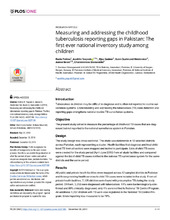| dc.contributor.author | Fatima, Razia | en_US |
| dc.contributor.author | Yaqoob, Aashifa | en_US |
| dc.contributor.author | Qadeer, Ejaz | en_US |
| dc.contributor.author | Hinderaker, Sven Gudmund | en_US |
| dc.contributor.author | Ikram, Aamer | en_US |
| dc.contributor.author | Sismanidis, Charalambos | en_US |
| dc.date.accessioned | 2020-06-22T10:36:37Z | |
| dc.date.available | 2020-06-22T10:36:37Z | |
| dc.date.issued | 2019-12-30 | |
| dc.Published | Fatima R, Yaqoob A, Qadeer E, Hinderaker SG, Ikram, Sismanidis. Measuring and addressing the childhood tuberculosis reporting gaps in Pakistan: The first ever national inventory study among children. PLOS ONE. 2019;14(12):e0227186 | eng |
| dc.identifier.issn | 1932-6203 | |
| dc.identifier.uri | https://hdl.handle.net/1956/22794 | |
| dc.description.abstract | Introduction Tuberculosis in children may be difficult to diagnose and is often not reported to routine surveillance systems. Understanding and addressing the tuberculosis (TB) case detection and reporting gaps strengthens national routine TB surveillance systems. Objective The present study aimed to measure the percentage of childhood TB cases that are diagnosed but not reported to the national surveillance system in Pakistan. Design The study design was cross sectional. The study was nationwide in 12 selected districts across Pakistan, each representing a cluster. Health facilities that diagnose and treat childhood TB from all sectors were mapped and invited to participate. Lists of child TB cases were created for the study period (April-June 2016) from all study facilities and compared against the list of child TB cases notified to the national TB surveillance system for the same districts and the same period. Results All public and private health facilities were mapped across 12 sampled districts in Pakistan and those providing health services to child TB cases were included in the study. From all private health facilities, 7,125 children were found with presumptive TB during the study period. Of them, 5,258 were diagnosed with tuberculosis: 11% were bacteriologically-confirmed and 89% clinically-diagnosed; only 4% were notified to National TB Control Program. An additional 1,267 children with TB were also registered in the National TB Control Program. Underreporting was measured to be 78%. Conclusion This is the first nationwide childhood TB inventory study globally and confirmed that childhood TB underreporting is very high in Pakistan. TB surveillance in the country must be strengthened to address this, with particular attention to guiding and supporting general practitioners and pediatricians to notify their TB cases. | en_US |
| dc.language.iso | eng | eng |
| dc.publisher | PLOS | eng |
| dc.rights | Attribution CC BY | eng |
| dc.rights.uri | http://creativecommons.org/licenses/by/4.0/ | eng |
| dc.title | Measuring and addressing the childhood tuberculosis reporting gaps in Pakistan: The first ever national inventory study among children | en_US |
| dc.type | Peer reviewed | |
| dc.type | Journal article | |
| dc.date.updated | 2020-01-17T10:54:09Z | |
| dc.description.version | publishedVersion | en_US |
| dc.rights.holder | Copyright 2019 Fatima et al. | |
| dc.identifier.doi | https://doi.org/10.1371/journal.pone.0227186 | |
| dc.identifier.cristin | 1769931 | |
| dc.source.journal | PLoS ONE | |

